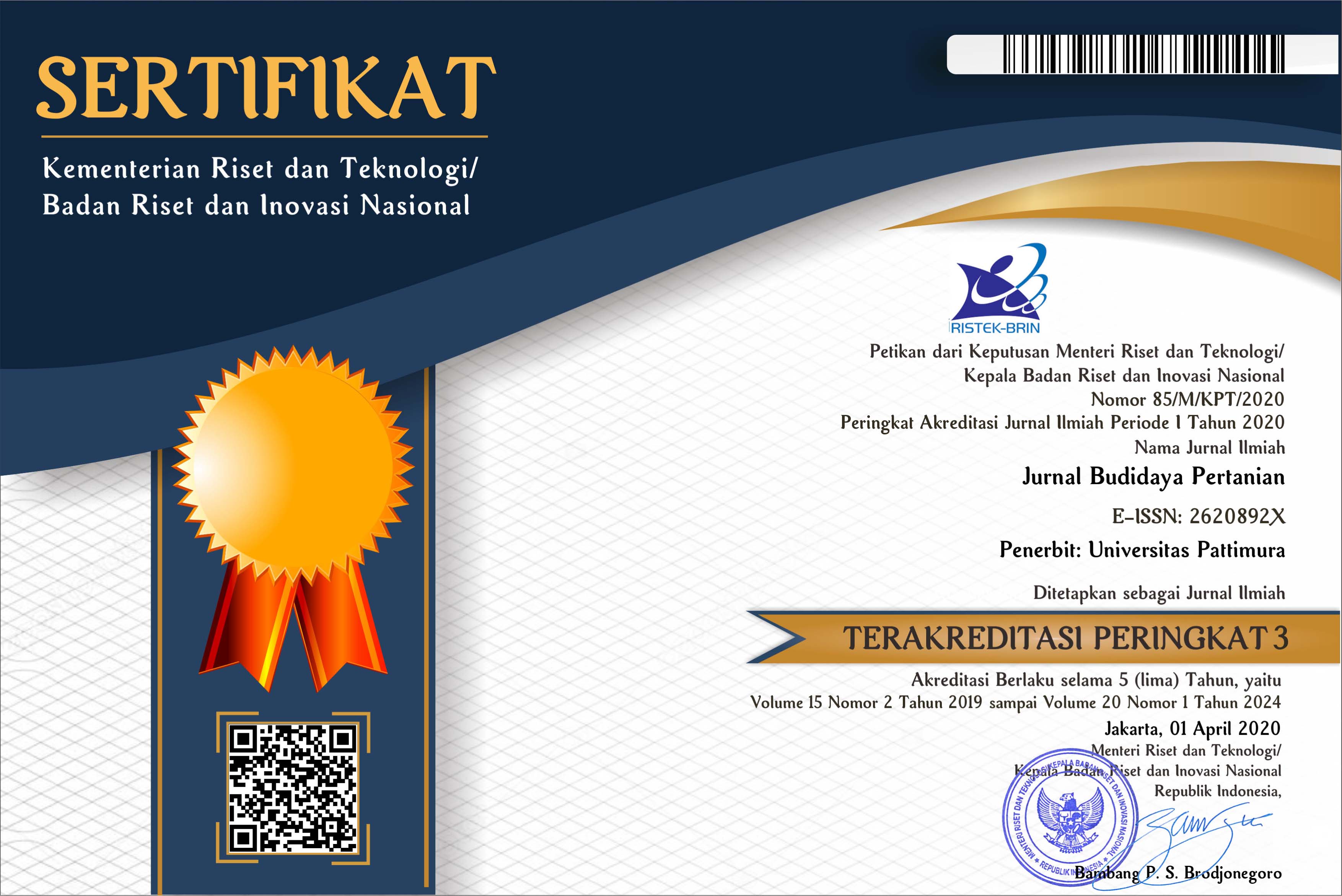Extension of the Eeigenvalue-Based Selection Index Method for Fixation of Multiple Trait-Transgressive Segregates in Mungbeans (Vigna radiata L. Wilczek)
Extension of the Eeigenvalue-Based Selection Index Method for Fixation of Multiple Trait-Transgressive Segregates in Mungbeans (Vigna radiata L. Wilczek)
Abstract
The selection of the early generation is a viable strategy for the rapid development of new plant varieties. In mungbeans (Vigna radiata L. Wilczek), the selection process is carried out to obtain high seed yield, early maturity, and sufficiently large seed size. To enhance this process, the extension of the combined-eigenanalysis selection index method (CESIM) with transgressive segregation variables can be used to fix multiple-trait transgressive segregates. Therefore, this research aimed to (1) develop an eigenvalue-based selection index method in information from relatives analysis capable of fixing multiple-trait transgressive segregates in the early generation, (2) predict expected and realized multiple-trait selection responses, and (3) verify the presence of multiple-trait transgressive segregates in the early generation of mungbeans. The material used consisted of the F3 generation population and its selection outcomes in F4, originating from the crossbreeding of mungbean varieties Gelatik × Lasafu Lere Butsiw. The empirical breeding values (EBV) between and within families were obtained using the BLUP values of the F3 generation from the mixed linear model with a nested design and log-normal distribution. The EBV values between families and dummy variables of transgressive segregate families were used in the selection process with CESIM. Furthermore, analysis of variance in EBV values within families in the F4 generation was applied to verify the presence of multiple-trait transgressive segregates. The results showed that the selection from the best CESIM equation yielded index scores with a determination coefficient R2 = 97.76% and an expected selection response of 136.62. The verification process confirmed the presence of 9 families as multiple-trait transgressive segregate families in the early generation.
Downloads
References
Bauer, A.M., Reetz, T.C., & Léon. J. (2006). Estimation of breeding value of inbred lines using best linear unbiased prediction (BLUP) and genetic similarities. Crop Science, 46,2685-2691.
Bos, I., & Caligari, P. (2008). Selection Methods in Plant Breeding. 2nd edition. Springer, New York.
Cerón-Rojas, J.J., Castillo-González, F., Sahagún-Castellanos, J., Santacruz-Verela, A., Benitez-Riquelme, I., & Crossa, J. (2008). A molecular selection index method based on eigenanalysis. Genetics, 180, 547-557.
Cerón-Rojas, J.J,, Crossa, J., Sahagún-Castellanos, J., Castillo-Gonzáles. F., & Santacruz-Verela, A. (2006). A selection index method based on eigenanalysis. Crop Science, 46,1711-1721.
Chadha, M.L. (2010). Short Duration Mungbean: A New Success in South Asia. Asia-Pacific Association of Agricultural Research Institutions. FAO Regional Office for Asia and the Pacific. APAARI, Bangkok.
Falconer, D.S., & Mackay, T.F.C. (1996). Introduction to Quantitative Genetics (4th Edition). Adison-Wesley Longman, Harlow UK.
Fernandez. G.C.J., & Shanmugasundaram, S. (1988). The AVRDC mungbean improvement program: the past, present and future. In Mungbean. Proceedings of the Second International Symposium. Asian Vegetable Research and Development Center, Taipei.
Hallauer, A.R., Carena, M.J., & Miranda Filho, J.B. (2010). Quantitative Genetics in Maize Breeding. Springer, New York.
Hazel, I.N. (1943). The genetic basis for constructing a selection indexes. Genetics, 28,476-490.
Jambormias, E., & Riry, J. (2009). Penyesuaian data dan penggunaan informasi kekerabatan untuk mendeteksi segregan transgresif sifat kuantitatif pada tanaman menyerbuk sendiri (suatu pendekatan dalam seleksi). Jurnal Budidaya Pertanian, 5(1),11-18 (In Indonesia).
Jambormias. E., Sutjahjo, S.H., Jusuf, M., & Suharsono. (2011). Using information from relatives and path analysis to select for yield and seed size in soybean (Glycine max L. Merrill). SABRAO Journal of Breeding and Genetics, 43(1),44-58.
Jambormias, E., Sutjahjo, S.H., Mattjik, A.A., Wahyu, Y., Wirnas, D., Siregar, A., Patty, J.R., Laisina, J.K., Madubun, E.L., & Ririhena, R.E. (2015). Transgressive segregation analysis of multiple traits in mungbean (Vigna radiata L. Wilczek). SABRAO Journal of Breeding and Genetics, 47(2),201-213.
Jambormias, E. (2014). Analisis Genetik dan Segregasi Transgresif Berbasis Informasi Kekerabatan untuk Produksi dan Panen Serempak Kacang Hijau. Dissertation. Sekolah Pascasarjana Institut Pertanian Bogor (in Indonesia).
http://repository.ipb.ac.id/bitstream/handle/123456789/69705/2014eja.pdf?sequence=1&isAllowed=y
Jolliffe, I.T. (2002). Principal Component Analysis. 2nd Ed. Springer-Verlag Inc., New York.
Kemphtorne, O., & Nordskog, A.W. (1959). Restricted selection indeces. Biometrics, 15,10-19.
Mattjik, A.A., Sumertajaya, I.M., Hadi, A.F., & Wibawa, G.N.A. (2011). Pemodelan Additive Main-effect & Multiplicative Interaction (AMMI): Kini dan Yang Akan Datang. IPB Press, Bogor (In Indonesia).
Moeljopawiro, S. (2002). Optimizing selection for yield using selection index. Zuriat, 13:35-42.
Muir, W.M. (2007). Comparison of genomic and traditional BLUP-estimated breeding value accuracy and selection response under alternative trait and genomic parameters. Journal of Animal Breeding and Genetics, 124,342-355.
Smith, H.F. (1936). A discriminant function for plant selection, pp. 666-476. In Papers on Quantitative Genetics and Related Topics. Department of Genetics, North Carolina State College, Releigh, NC.
Viana, J.M.S., de Almeida, R.V., Varia, V.R., de Resende, M.D.V., & e Silva, F.F. (2011). Genetic evaluation inbred plant based on BLUP of breeding value and general combining ability. Crop & Pasture Science, 62,515-522.
Walsh, B. (2010). Theory of Index Selection. Course of Quantitative Genetics of Selection Response. Wageningen University, the Netherlands. 7-11 June 2010. http://nitro.biosci.ari-zona-.edu/workshops/Wag2010/pdf/Chap-ter33.pdf
Wirnas, D., Widodo, I., Sobir, Trikoesoemaningtyas, & Sopandie, D. (2006). Pemilihan karakter agronomi untuk menyusun indeks seleksi pada 11 populasi Generasi F6. Buletin Agronomi, 34(1):19-24 (in Indonesia).
Copyright (c) 2024 Edizon Jambormias, Surjono Hadi Sutjahjo, Ahmad Ansori Mattjik, Yudiwanti Wahyu, Desta Wirnas, Jacob Richard Patty

This work is licensed under a Creative Commons Attribution-ShareAlike 4.0 International License.

 Accreditation is valid for 5 years, starting from Volume 15 Issues 2 December 2019 up to Volume 20 Issue 1 June 2024.
Accreditation is valid for 5 years, starting from Volume 15 Issues 2 December 2019 up to Volume 20 Issue 1 June 2024.






